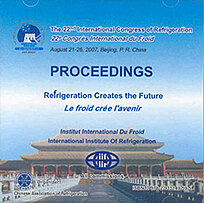
IIR document
Experimental studies of supercooled ice slurry production.
Author(s) : BEDECARRATS J. P., STRUB F., DAVID T., et al.
Summary
Ice slurry can be generated in different ways. One of them consists in producing ice from supercooled water or aqueous solution. Indeed, water flowing in an exchanger can be cooled at a temperature lower than its melting point without crystallising on the walls of this one. After leaving the exchanger, the supercooled water flow is physically disturbed in order to generate ice crystals. The ice fraction depends on the level of supercooling of the liquid leaving the exchanger and increases by approximately 1.26% per supercooling degree for pure water. The first difficulty is to make the supercooled water flow. In the presented system, the water is supercooled directly into the evaporator of the refrigerating plant. The supercooled water is a fluid which needs special care in handling. The influence of different parameters on its crystallization have been experimentally studied: level of supercooling, flow rate, refrigerant fluid temperature. The results have shown the difficulty to control a plant where the supercooling phenomenon is present. The stochastic character of the crystallization interferes with the reproducibility of the results. However, the results show that it is possible to make supercooled water until -2°C without freezing the water in the exchanger. But, the water outlet optimal temperature is about of -1.6°C with a Reynolds number of 3400 in order to have enough safety margin to avoid the breakdown of supercooling inside the tube of the exchanger.
Available documents
Format PDF
Pages: ICR07-B1-1287
Available
Public price
20 €
Member price*
Free
* Best rate depending on membership category (see the detailed benefits of individual and corporate memberships).
Details
- Original title: Experimental studies of supercooled ice slurry production.
- Record ID : 2007-2104
- Languages: English
- Source: ICR 2007. Refrigeration Creates the Future. Proceedings of the 22nd IIR International Congress of Refrigeration.
- Publication date: 2007/08/21
Links
- See translations: Producción de pasta de hielo sobreenfriada estudios experimentales.
See other articles from the proceedings (839)
See the conference proceedings
Indexing
- Themes: Indirect refrigeration systems
- Keywords: Ice slurry; Supercooling; Process; Expérimentation; Secondary refrigerant; Water
-
Ice slurry formation based on nanofluid and hyd...
- Author(s) : WU P., ZHANG X. J., QIU L. M.
- Date : 2008/04/05
- Languages : English
- Source: Cryogenics and refrigeration. Proceedings of ICCR'2008.
View record
-
Paraffin phase change slurries.
- Author(s) : GSCHWANDER S., SCHOSSIG P.
- Date : 2006/09/13
- Languages : English
- Source: 7th Conference on Phase-Change Materials and Slurries
- Formats : PDF
View record
-
Pressure drop and heat transfer characteristics...
- Author(s) : LEE D. W., LEE S. M.
- Date : 2005/06/15
- Languages : English
- Source: Proceedings of the sixth Workshop on Ice Slurries of the IIR/Proceedings of the Second Conference on Phase Change Material and Slurry (PCM 2005).
- Formats : PDF
View record
-
Why applications of ice slurry is so low?
- Author(s) : RIVET P.
- Date : 2006/09/13
- Languages : English
- Source: 7th Conference on Phase-Change Materials and Slurries
- Formats : PDF
View record
-
Influence of surface roughness on the supercool...
- Author(s) : FAUCHEUX M., MULLER G., HAVET M., et al.
- Date : 2005/06/15
- Languages : English
- Source: Proceedings of the sixth Workshop on Ice Slurries of the IIR/Proceedings of the Second Conference on Phase Change Material and Slurry (PCM 2005).
- Formats : PDF
View record
